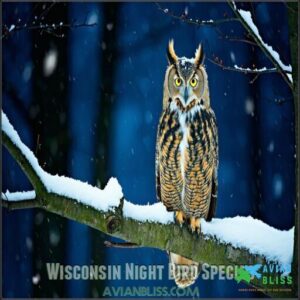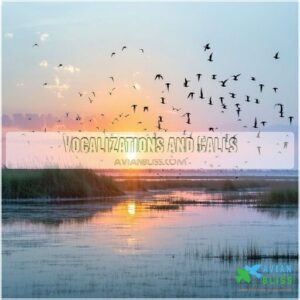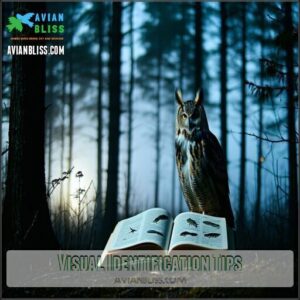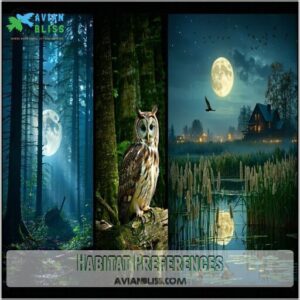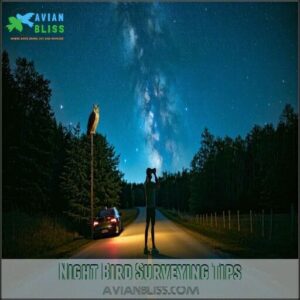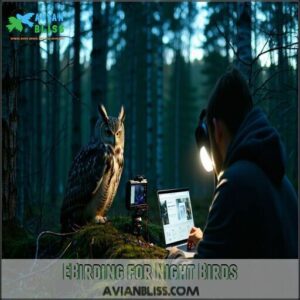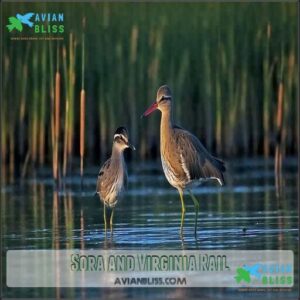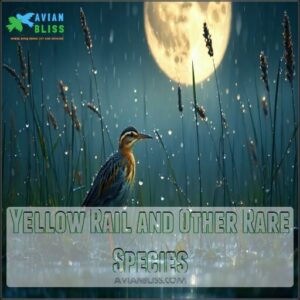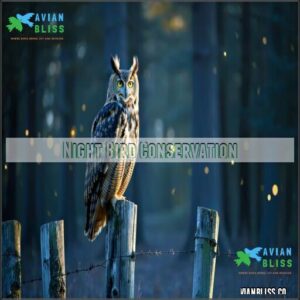This site is supported by our readers. We may earn a commission, at no cost to you, if you purchase through links.
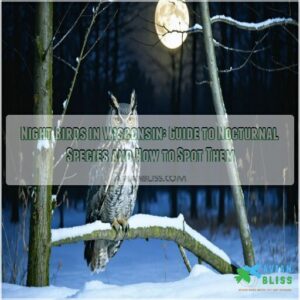
Great Horned and Barred Owls are year-round residents, known for their haunting calls. You’ll also find Eastern Whip-poor-wills in summer, blending into woodlands with their soft, rhythmic songs.
Near wetlands, listen for the quirky “pump-er-lunk” sound of American Bitterns or the eerie whistle of Soras. These birds are most active from dusk to dawn, making quiet nights ideal for spotting them.
A good flashlight, patience, and sharp ears are all you need to explore their habitats, which adds a sense of wonder—after all, who doesn’t love secrets whispered in the dark?
Table Of Contents
- Key Takeaways
- Night Birds in Wisconsin
- Wisconsin Night Bird Species
- Identifying Night Birds
- Night Bird Surveying Tips
- EBirding for Night Birds
- Species-Specific Information
- Night Bird Conservation
- Getting Involved in Night Bird Atlasing
- Frequently Asked Questions (FAQs)
- What Should I Bring With Me if I Want to Observe Night Birds in Wisconsin?
- What Are the Differences Between Diurnal and Nocturnal Bird Species?
- Are There Any Conservation Efforts in Place for Night Birds in Wisconsin?
- What birds are out at night in Wisconsin?
- What type of birds come out at night?
- What bird chirps at 2am?
- What bird do I hear chirping at night?
- What animals make noise at night in Wisconsin?
- What kind of bird makes a lot of noise at night?
- Which of the following birds is nocturnal?
- Conclusion
Key Takeaways
- Discover Wisconsin’s night birds by listening for calls like the Barred Owl’s “who-cooks-for-you” hoot or the Eastern Whip-poor-will’s rhythmic chant at dusk or dawn.
- Explore marshes, forests, and grasslands to spot elusive species like American Bitterns, Soras, and Common Nighthawks, especially on calm, clear nights.
- Contribute to conservation by joining nocturnal atlasing, reducing light pollution, and protecting habitats like wetlands and forest edges.
- Use tools like flashlights, binoculars, and the eBird app to document observations, identify species, and map patterns for citizen science efforts.
Night Birds in Wisconsin
Wisconsin’s night birds include a fascinating mix of owls, nightjars, and marshbirds, each adapted to thrive in the dark.
By understanding their habits and habitats, you can increase your chances of spotting these elusive species.
Discover the beauty of Wisconsin’s elusive night birds by exploring their hidden habitats and listening to their unique nighttime calls.
Overview of Nocturnal Atlasing
Curious about nighttime birding? Nocturnal atlasing is your gateway to uncovering Wisconsin’s hidden nocturnal birds.
By participating, you contribute to the Wisconsin bird atlas and aid conservation impact.
Here’s how to get started:
- Listen for calls like owl hoots or nightjar songs during quiet nights.
- Map distributions by recording observations in key habitats.
- Join citizen science efforts to support data collection and track species trends.
Time of Year and Day for Surveying
Understanding optimal timing for spotting nocturnal birds in Wisconsin hinges on seasonal variations and daily cycles.
Birds are most active during specific months and hours:
- Early Spring (March-April): Great Horned and Barred Owls call loudly at night, marking their territories.
- Late Spring to Early Summer (May-June): Migration brings Soras and Whip-poor-wills, filling evenings with their distinct songs.
- Mid-Summer (June-July): Common Nighthawks perform aerial displays at dusk, while Yellow Rails emit soft "ticks" near wetlands.
Moon phases also influence activity—full moons often enhance visibility and calls.
Shorter summer nights compress activity into narrow windows.
For successful nocturnal surveys, focus on calm, clear nights near dawn or dusk to capture the magic of nighttime birding.
Enhance your viewing with specialized viewing equipment.
Survey Strategy for Night Birds
To get the most out of nocturnal bird surveys, plan carefully.
Choose quiet backroads or areas with marshes, grasslands, or forest edges—prime nocturnal bird habitats. Start during crepuscular hours (dawn or dusk) when nocturnal bird activity peaks.
Stop every 0.5–1 mile, remain still for 5–10 minutes, and listen closely. You might catch the Barred Owl’s hoot, a Sora’s whistle, or even a bittern’s booming call.
Pack essential tools like flashlights, field guides, and recording devices for data analysis. Consider acoustic monitoring equipment to capture elusive sounds.
Route selection and volunteer training are key for effective nocturnal bird monitoring. A little patience goes a long way in uncovering Wisconsin’s nocturnal bird species!
Wisconsin Night Bird Species
Wisconsin is home to a fascinating range of nocturnal bird species, including owls, nightjars, and marshbirds, each adapted to thrive in the dark.
These birds play essential ecological roles, from controlling insect populations to maintaining wetland health.
Owls and Their Breeding Habits
Owls in Wisconsin have fascinating nesting habits, each species showcasing unique strategies for raising their young.
Here’s how four common owl species approach breeding:
- Great Horned Owl: These adaptable Wisconsin owls nest as early as January, often reusing hawk nests or tree cavities.
- Barred Owl: Preferring large, hollow trees, they begin nesting in late winter, raising clutches of 2-3 eggs.
- Barn Owl: Rare in Wisconsin, they seek secluded sites like barns, with incubation lasting about 30 days.
- Eastern Screech-Owl: These small owls favor urban woodlands, nesting in cavities and caring painstakingly for their fledglings.
Habitat selection and fledgling care are vital for their survival.
Nightjars in Wisconsin
Nightjars in Wisconsin, including the Eastern Whip-poor-will, Common Nighthawk, and rare Chuck-will’s-widow, are masters of camouflage and nocturnal bird calls.
The Whip-poor-will song echoes through open woodlands, while Nighthawk migration peaks in late summer, showcasing their aerial acrobatics as they hunt an insect diet.
Habitat loss threatens these species, contributing to nightjar decline. Identifying nightjars relies on recognizing their unique calls and spotting them in twilight skies.
Protecting their habitats guarantees these enchanting birds remain a fundamental part of Wisconsin’s ecosystem, enriching your night bird identification adventures.
Marshbirds and Their Habitats
Wetland habitats play a big role in supporting marshbirds, offering food, shelter, and breeding grounds amidst Wisconsin’s marshy landscapes.
These birds are part of the rich ecosystem that thrives at night.
- American Bitterns blend seamlessly in dense sedge vegetation, making their "gulping" calls a rare delight.
- Least Bitterns favor calm, shallow waters lined with cattails, providing a quiet scene for their secretive lives.
- Soras and Virginia Rails stick close to wetland edges, foraging where water meets lush greenery.
Protecting wetland ecology guarantees marshbirds like the Yellow Rail continue enchanting Wisconsin nights while combating habitat loss effectively.
Nocturnally-active Sparrows
From marshy wetlands to quiet fields, nocturnally-active sparrows add subtle intrigue to Wisconsin’s nightscape.
With their delicate songs and secretive habits, these small nocturnal birds are a pleasure to observe for those who pay attention after dusk.
Sparrows show fascinating nocturnal behavior, such as alertness during storms or silent foraging at night.
Their varied diets include seeds, insects, and small plants, making them essential to local ecosystems.
Preserving sparrow habitats aids their conservation, given threats like habitat loss and declining populations.
Listen closely for these species:
- Song Sparrow: Simple melodies call from shrubs near wetlands.
- Swamp Sparrow: Gentle chirps rise from marshes.
- White-throated Sparrow: Soft whistles echo in woods.
- Savannah Sparrow: Fields host their faint, rhythmic chirps.
Identifying Night Birds
You can identify night birds by listening for their unique calls and observing their silhouettes against the night sky.
Pay attention to their preferred habitats and activity patterns, which often reveal their presence.
Vocalizations and Calls
Listening to nocturnal bird sounds is a journey into Wisconsin’s nighttime orchestra.
Each call reveals a story. The Barred Owl, with its famous “who-cooks-for-you?” hoot, resonates through wooded areas, while the Eastern Whip-poor-will sings a steady, rhythmic chant near open spaces.
Other owl species in Wisconsin, like the Eastern Screech-Owl, add soft trills or distinct whinnies, creating diverse tones. Nightjar songs, such as the Common Nighthawk’s nasal peent, offer a sharp contrast to heron calls, which are harsher and squawk-like.
Recognizing call variations helps identify species in the dark.
Equip yourself with a recording device, study patterns, and experience the beauty of these enchanting bird sounds Wisconsin nights offer.
Visual Identification Tips
When spotting Wisconsin’s nocturnal birds, focus on details under soft moonlight.
Observing plumage patterns, flight styles, and silhouette recognition can pinpoint species even in low light.
Keep binoculars handy to catch:
- Feather markings distinct to owl species Wisconsin birders know well.
- Wing shapes and size comparisons to detect diurnal lookalikes.
- Beak shapes, revealing feeding behaviors.
Patience is key.
Watching their unique movements — like swooping barn owls or gliding nighthawks — enhances your bird identification experience.
Habitat Preferences
Understanding bird habitats helps you spot Wisconsin’s night birds.
Forest Habitats shelter owls, blending into shadowy trees.
Wetland Sanctuaries, like cattail marshes, host marshbirds, including the American Bittern.
Urban Adaptations support Common Nighthawks, often nesting on rooftops.
Open Woodlands attract Yellow Rails in shrubby swamps.
Farmland Havens provide space for nocturnal birds like the Short-eared Owl.
Explore Wisconsin wildlife at night to see these incredible species.
| Habitat | Common Birds | Key Features |
|---|---|---|
| Forest Habitats | Barred Owl, Screech-Owl | Dense vegetation |
| Wetland Sanctuaries | American Bittern, Sora | Cattails, soft mud |
| Urban Adaptations | Common Nighthawk | Rooftops, streetlights |
Night Bird Surveying Tips
To effectively survey night birds in Wisconsin, focus on timing, location, and weather conditions.
Use quiet roads and listening stations to increase your chances of detecting calls in their natural habitats.
Weather and Habitat Considerations
Weather patterns and habitat types strongly influence your chances of spotting Wisconsin’s night birds.
Clear skies and calm winds create ideal listening conditions, while rain or gusts above 10 mph can muffle their calls.
Seasonal impacts also shape bird activity, with moonlit nights—especially those with over 50% visibility—offering the best opportunity for observation.
Focus on a variety of nocturnal habitats, such as wetlands or forests, for greater success.
Microclimates within these areas, like sheltered groves, often host more active birds.
Climate change can affect breeding areas, so seek stable regions supporting resilient bird populations.
Saltwater wetlands attract specialized shorebirds.
To increase your odds:
- Choose nights with minimal weather disturbance.
- Visit diverse bird habitats.
- Prioritize native vegetation areas.
- Avoid urban night pollution.
- Respect nocturnal bird ecosystems.
Road Surveys and Listening Techniques
Road surveys offer an engaging way to experience nocturnal birding. Plan your survey route design along quiet roads with low traffic.
Drive slowly with windows down, stopping every 0.5-1 mile to listen for calls from night birds like owls or Nightjars. Use call identification practice by recording bird sounds with audio tools, which helps with later analysis.
A flashlight can highlight the reflective eyes of nocturnal birds—make sure your equipment calibration guarantees peak performance. Accurate surveys often rely on specialized measurement tools for precise data collection.
Combine these methods with data recording practices to track observations accurately. Remember, patience is key. Whether it’s a Whip-poor-will’s song or an owl’s hoot, road surveys promise an incredible way to connect with Wisconsin’s night birds.
Safety Precautions and Best Practices
For safe nighttime birding in Wisconsin, preparation is key. Stay visible with reflective clothing and pack sturdy boots, a phone, and a first-aid kit. Don’t forget a flashlight—preferably one that preserves night vision.
Here’s how to keep your surveys safe:
- Stay Alert: Listen for night birds, but also for cars if surveying near roads.
- Mind Your Steps: Uneven trails can surprise you—watch where you walk.
- Weather-Ready: Check forecasts to avoid sudden storms.
- Ethical Observation: Respect bird habitats by staying quiet, keeping a distance, and avoiding stress on nocturnal birds.
For increased visibility, consider investing in specialized birding gear.
EBirding for Night Birds
You can use eBird to log your nocturnal birding efforts, track species, and contribute to valuable data for science.
Breaking your checklist by specific times or locations guarantees accurate records of your night bird observations, which helps in valuable data for science.
Calculating Night Effort
Timing matters when observing nocturnal birds in Wisconsin.
Start about 20 minutes after sunset or 40 minutes before sunrise for the best detection probability.
Use smart Effort Calculation Methods to track Survey Time Allocation.
Tools like eBird refine Data Standardization and reveal patterns in nightjars Wisconsin populations.
Observer Skill Impact shapes results, so stay consistent.
| Observation Period | Start Time Example | Ideal Bird Activity |
|---|---|---|
| Post-Sunset | 8:20 PM (summer) | Higher chance of owls |
| Pre-Sunrise | 4:40 AM (spring) | Active nightjars |
| Full Moon Nights | Adjust to moonrise | Best for marshbirds |
| Overcast Conditions | Sunset-based timing | General night birding |
Splitting Checklists and Entering Effort
Keeping your checklist accurate is simple with Checklist Management. Break efforts into manageable periods, like 40 minutes before sunrise or 20 minutes after sunset. Even during quiet nights, record your effort hours—it supports data integrity for nocturnal bird studies in Wisconsin.
Breeding codes improve protocol adherence when logging night observations of species like Barred Owls. Following these responsible bird watching guidelines helps protect the species.
- Split by Timing: Log data during distinct intervals.
- Track Everything: Always document effort, even without sightings.
- Collaborate: Note multiple observers for better accuracy.
Tips for Effective EBirding
eBird is a fantastic tool for tracking nocturnal birds during Wisconsin birdwatching adventures.
Here’s how to make the most of it:
- Prioritize Data Entry: Keep checklist accuracy high by including effort details like time spent, distance covered, and any absences. Every bit matters!
- Use Media Uploads: Record sounds and upload them for night bird identification. Audio captures can support species verification.
- Ensure Location Specificity: Pin exact spotting locations. This aids researchers studying night birds’ habitats across Wisconsin.
These steps simplify your eBird experience, turning data into conservation gold.
Species-Specific Information
In Wisconsin, each night bird species has unique traits that make them fascinating to observe.
You’ll learn how to identify key species like bitterns, rails, and other elusive nocturnal birds by their habitats, calls, and behaviors.
American Bittern and Least Bittern
American Bitterns and Least Bitterns are elusive marshbirds thriving in Wisconsin’s wetlands.
You’ll find American Bitterns blending into sedge marshes, their distinct “glunk” call echoing at dusk. Least Bitterns, smaller and agile, favor cattail marshes, calling with a rapid “kek-kek-kek.”
Bittern identification can be tricky due to their camouflage and secretive nature.
Habitat loss threatens these night birds, making wetland conservation essential.
Both species feed on insects, fish, and amphibians, showcasing subtle diet comparison differences. Spotting them rewards your patience!
Sora and Virginia Rail
As the marsh quiets after sunset, the Sora and Virginia Rail come alive with their distinctive calls—serenading Wisconsin’s wetlands.
These marshbirds thrive in aquatic habitats, offering a glimpse into wetland ecology.
- Sora habitat: Soras prefer small ponds or cattail-covered marshes, especially during migration.
- Rail vocalizations: Soras produce high-pitched whinnies, while Virginia Rails grunt in rhythmic bursts that echo the night.
- Wetland ecology: Virginia Rails feast on insects, worms, and seeds, playing a key role in keeping marsh ecosystems balanced.
Protecting wetlands guarantees these night birds’ melodies enrich Wisconsin’s wild nights for generations.
Yellow Rail and Other Rare Species
Tucked away in Wisconsin’s sedge marshes, the Yellow Rail is one of the most secretive night birds you’ll encounter.
Its rhythmic “tic-tic-tic” resembles insect sounds, making it tricky to pinpoint.
Found mainly in the northern half of the state, this rare species relies on wetlands like those rich with bluejoint grass for survival.
Habitat loss and degradation are pressing challenges for these marsh-loving nocturnal birds.
Protecting Yellow Rail habitat through restoration and monitoring is key to safeguarding rare Wisconsin birds like this enigmatic marsh dweller.
Night Bird Conservation
Protecting Wisconsin’s night birds starts with understanding the challenges they face, like habitat loss and light pollution.
You can support their conservation by participating in nocturnal atlasing or adopting bird-friendly practices in your community.
Importance of Nocturnal Atlasing
Observing Wisconsin night birds can feel magical, but your efforts contribute to much more than wonder—they’re key for nocturnal atlasing.
By surveying during peak activity, you’re creating valuable records for conservation efforts.
Here’s how your observations make a difference:
- Map owl and nightjar breeding patterns—listening for their distinct calls provides precise data.
- Track marshbird behaviors—understanding their nesting habits helps guide habitat management.
- Monitor population trends—collecting data year after year shows how species adapt or decline.
- Assess habitats—noting where nocturnal birds thrive identifies critical areas worth protecting.
This citizen science effort gives experts the tools to monitor population health and understand the ecology of nocturnal birds.
You’re not just birdwatching—you’re shaping the future of Wisconsin’s natural spaces.
Threats to Night Bird Populations
Nocturnal birds in Wisconsin face mounting challenges, threatening their survival.
Habitat loss from urban sprawl and shrinking wetlands eliminates key nesting and feeding areas.
Light pollution disorients these night travelers during migration, luring them into cities where exhaustion or fatal collisions with buildings often occur.
Climate change adds to the strain, bringing erratic weather and drying wetlands that disrupt ecosystems birds depend on.
Pesticide exposure further reduces their already dwindling food supply, particularly for insect-eaters like nighthawks.
Even vehicles and man-made structures claim countless birds each year, with collisions taking a notable toll.
These intertwined bird threats create a tough environment, pushing populations like whip-poor-wills into steep decline.
Understanding and addressing habitat loss, climate change, and other pressures is essential to ensuring their enchanting calls continue to echo through Wisconsin’s nights.
Ways to Support Night Bird Conservation
You can make a real difference in nocturnal bird conservation in Wisconsin with a few simple steps. Here’s how:
- Reduce light pollution by using motion-sensor lights or shielding outdoor fixtures. This supports nocturnal birds, helping species like owls and nightjars migrate safely.
- Support habitat preservation by planting native trees or donating to organizations like Goose Pond Sanctuary. Healthy habitats are essential for nesting and feeding.
- Install nest box programs or advocate for bird-smart glass to prevent collisions. Both protect birds like Eastern Screech-Owls and preserve their populations.
You can also donate to reputable charities to further these efforts.
Getting Involved in Night Bird Atlasing
You can contribute to important research and conservation efforts by participating in nocturnal atlasing, where volunteers document night bird activity across Wisconsin.
This hands-on approach helps scientists track populations, identify trends, and protect these fascinating species.
How to Participate in Nocturnal Atlasing
If you’re keen to uncover Wisconsin’s nocturnal birds, nocturnal atlasing is your gateway to adventure. Start on calm nights from late March to July, using atlas techniques like stopping every 0.5–1 mile along quiet roads.
Gear up with reliable atlas equipment: headlamp, binoculars, reflective wear, and a field notebook. Don’t forget the eBird app for smooth data submission. Millions of birds depend on celestial navigation methods during these migrations.
Explore efficiently by pairing with a birding buddy for safer fieldwork. Listen for distinct calls—from the whip-poor-will’s haunting melody to the Great Horned Owl’s hoot. Your contributions support skill development and bolster the atlas impact for conservation.
Here’s a quick checklist:
Checklist Tips Benefits
Joining The Night Bird Community
Engaging with Wisconsin’s vibrant birding community opens doors to knowledge, connection, and conservation. Local chapters and mentorship programs welcome birders of all levels, offering guidance and camaraderie as you explore the realm of nocturnal birds.
Citizen science initiatives, like statewide surveys, let you support research while refining your bird-watching skills. Participating in these surveys offers firsthand experience with Wisconsin’s night birds, from Barred Owls to Whip-poor-wills.
Seasonal night tours and workshops deepen your understanding of their habitats and behaviors. Community outreach programs create inclusive spaces for everyone to join, ensuring birding in Wisconsin feels welcoming.
You’ll find opportunities to meet fellow enthusiasts, share tips, and contribute to conservation efforts.
- Join seasonal owl-watching or night bird tours.
- Volunteer for habitat protection projects.
- Participate in birding mentorship programs for skill development.
Frequently Asked Questions (FAQs)
What Should I Bring With Me if I Want to Observe Night Birds in Wisconsin?
Picture a quiet evening under starlit skies.
Bring binoculars, a flashlight with red filters, a field guide, warm clothes, insect repellent, and a notepad.
Stay quiet, patient, and enjoy nature’s nighttime symphony.
What Are the Differences Between Diurnal and Nocturnal Bird Species?
Diurnal birds, active in daylight, rely on sharp color vision to hunt and navigate.
While nocturnal birds excel at low-light hunting using enhanced night vision, silent flight, and advanced hearing, adapting perfectly to their nighttime environment, utilizing sharp abilities is not their forte, but rather a result of their adaptation.
Are There Any Conservation Efforts in Place for Night Birds in Wisconsin?
Wisconsin protects night birds through habitat preservation, light pollution control, and monitoring programs like the Nightjar Survey.
Conservation groups promote bird-friendly practices, sustainable forestry, and initiatives like nest box installations to support these important nocturnal species.
What birds are out at night in Wisconsin?
When the moon lights up Wisconsin’s sky, owls hoot from the forests, nightjars whisper their songs, and herons wade silently in wetlands.
Each species thrives under cover of darkness, creating a magical nighttime orchestra.
What type of birds come out at night?
At night, you can spot owls, nightjars, mockingbirds, and herons.
Owls hunt silently, nightjars swoop for insects, mockingbirds sing their hearts out, and herons wade through wetlands.
Each bird’s activity fills the night with life.
What bird chirps at 2am?
If you’re hearing chirping at 2 a.m., it’s probably a Northern Mockingbird serenading the night.
These birds love moonlit concerts, often mimicking other sounds while searching for mates or protecting their territory.
What bird do I hear chirping at night?
You might be hearing a Northern Mockingbird or an Eastern Whip-poor-will.
Mockingbirds sing melodious nighttime tunes, while Whip-poor-wills are famous for their rhythmic calls, often filling quiet nights with their songs.
What animals make noise at night in Wisconsin?
If you’re trying to pinpoint nighttime noises in Wisconsin, it’s likely owls, frogs, or coyotes.
Barred owls hoot, frogs croak from wetlands, and coyotes give eerie howls.
Each adds to Wisconsin’s nocturnal symphony.
What kind of bird makes a lot of noise at night?
The Eastern Whip-poor-will often takes the spotlight at night with its rhythmic, three-syllable "whip-poor-will" song.
Great Horned Owls also stand out with their iconic hoots, adding drama to the nocturnal symphony.
Which of the following birds is nocturnal?
Like shadows in the moonlight, nocturnal birds stay active when the world sleeps.
Owls, nightjars like Whip-poor-wills, and herons, such as Black-crowned Night-Herons, hunt or sing under the stars, thriving in darkness.
Conclusion
Spotting night birds in Wisconsin blends curiosity, calm, and careful listening.
From owls making haunting hoots to nightjars softly singing, these nocturnal creatures reward patience and observation.
Use a flashlight, know your habitats, and keep your ears sharp for distinct calls like the American Bittern’s "pump-er-lunk."
Whether surveying wetlands or woodlands, nighttime offers unique opportunities to explore these secretive species.
By learning their behaviors, you’ll uncover the fascinating world of Wisconsin’s nocturnal avian life.

